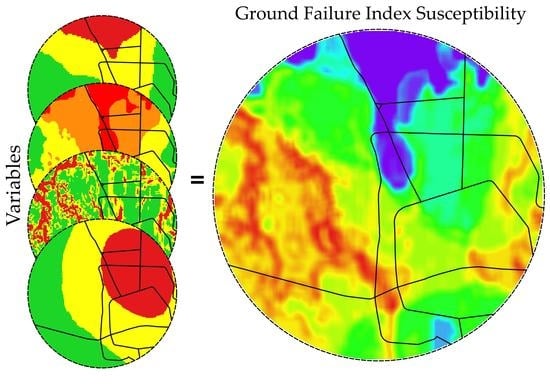Determination of Susceptibility to the Generation of Discontinuities Related to Land Subsidence Using the Frequency Ratio Method in the City of Aguascalientes, Mexico
Abstract
1. Introduction
Description of the Study Area
2. Materials and Methods
- (a)
- (b)
- The LOS deformation accumulated during the analysis period was calculated from the results of previous investigation [40] in which a subsidence velocity map of the Aguascalientes Valley based on 34 ALOS satellite INSAR images was developed using the SBAS technique. The subsidence values were categorized into 4 classes as shown in Figure 3b. Although the variable associated with the generation of fractures is the vertical deformation, for this work, the LOS deformation was used, which was proportional to the real vertical subsidence.
- (c)
- (d)
- The water table drawdown was calculated from the difference between the water table level in 2011 and that in 2007; the data was obtained from the official CONAGUA website [43]. The magnitude of the drawdown was classified into 3 classes as shown in Figure 3d. In total, 101 wells within the Aguascalientes Valley were used, the location of which is shown in Figure 4.
3. Results
- (a)
- According to the graph in Figure 7a, the sediment thickness variable showed a behavior that was inversely proportional to the frequency ratio, meaning that zones with a lower thickness of fillings had a higher frequency ratio, i.e., they are areas where a greater number of discontinuities have occurred. This is consistent with the conceptual models of fracture generation reported by [6,21,22,24]. These models show that the generation of discontinuities takes place in zones where the underlying bedrock of the aquifer is shallower. This occurs where there is a lateral change in the depth of the aquifer.
- (b)
- The graph of the accumulated deformation versus the frequency ratio (Figure 7b) suggests that the zone where the highest number of fractures has occurred was not where the deformation was the highest or the lowest; instead, the highest number of fractures occurred in the zone that corresponded to the intermediate values of accumulated deformation. According to the subsidence conceptual models [6,21,22,24], a greater sediment thickness produces greater deformation, and a smaller sediment thickness produces less deformation. Therefore, the highest number of fractures should occur in the zone of transition from the thinner to the thicker sediment layers, i.e., in the subsidence zone with intermediate values as shown in the graph of Figure 7b.
- (c)
- The graph in Figure 7c, which shows the frequency relationship between the subsidence gradient and the occurrence of fractures, presents a directly proportional relationship. This means that the highest number of fractures was observed in areas with a higher horizontal subsidence gradient, which is consistent with a study carried out in México City [35] in which the authors used the horizontal subsidence gradient as a parameter to identify the fracturing zones.
- (d)
- The graph in Figure 7d suggests an inversely proportional relationship between the generation of fractures and the lowering of the water table. Figure 7d shows that the highest number of fractures occurred outside the cone of depression, which is consistent with [44,45]. They noted that the greatest subsidence occurs in areas where the lowering of the water table is highest; that fractures occur at the edges of the subsidence zone; and that, therefore, they occur outside the cone of depression, where the water level drop is lower.
4. Discussion
5. Conclusions
Author Contributions
Funding
Data Availability Statement
Conflicts of Interest
References
- Galloway, D.L.; Burbey, T.J. Review: Regional Land Subsidence Accompanying Groundwater Extraction. Hydrogeol. J. 2011, 19, 1459–1486. [Google Scholar] [CrossRef]
- Chaussard, E.; Wdowinski, S.; Cabral-Cano, E.; Amelung, F. Land Subsidence in Central Mexico Detected by ALOS InSAR Time-Series. Remote Sens. Environ. 2014, 140, 94–106. [Google Scholar] [CrossRef]
- Figueroa-Miranda, S.; Tuxpan-Vargas, J.; Ramos-Leal, J.A.; Hernández-Madrigal, V.M.; Villaseñor-Reyes, C.I. Land Subsidence by Groundwater Over-Exploitation from Aquifers in Tectonic Valleys of Central Mexico: A Review. Eng. Geol. 2018, 246, 91–106. [Google Scholar] [CrossRef]
- Cigna, F.; Tapete, D. Land Subsidence and Aquifer-System Storage Loss in Central Mexico: A Quasi-Continental Investigation with Sentinel-1 InSAR. Geophys. Res. Lett. 2022, 49, e2022GL098923. [Google Scholar] [CrossRef]
- Villaseñor-Reyes, C.I.; Hernández-Madrigal, V.M.; Figueroa-Miranda, S. Identification and Assessment of Land Subsidence Development in Rural Areas Using PS Interferometry: A Case Study in Western Michoacan, Mexico. Environ. Earth Sci. 2022, 81, 417. [Google Scholar] [CrossRef]
- Pacheco-Martínez, J.; Hernandez-Marín, M.; Burbey, T.J.; González-Cervantes, N.; Ortíz-Lozano, J.Á.; Zermeño-de-León, M.E.; Solís-Pinto, A. Land Subsidence and Ground Failure Associated to Groundwater Exploitation in the Aguascalientes Valley, México. Eng. Geol. 2013, 164, 172–186. [Google Scholar] [CrossRef]
- Aranda-Gómez, J.J. Geología preliminar del Graben de Aguascalientes. Rev. Mex. Cienc. Geol. 1989, 8, 22–31. [Google Scholar]
- Holzer, T.L. Ground Failure Induced by Graund-Water Withdrawal from Unconsolidated Sediment. Rev. Eng. Geol. 1984, 6, 67–104. [Google Scholar] [CrossRef]
- Fatolahzadeh, S.; Nadi, B.; Ajalloeian, R. Land Subsidence Susceptibility Zonation of Isfahan Plain Based on Geological Bedrock Layer. Geotech. Geol. Eng. 2022, 40, 1989–1996. [Google Scholar] [CrossRef]
- Rezaei, M.; Yazdani Noori, Z.; Dashti Barmaki, M. Land Subsidence Susceptibility Mapping Using Analytical Hierarchy Process (AHP) and Certain Factor (CF) Models at Neyshabur Plain, Iran. Geocarto Int. 2022, 37, 1465–1481. [Google Scholar] [CrossRef]
- Chitsazan, M.; Rahmani, G.; Ghafoury, H. Land Subsidence Susceptibility Mapping Using PWRSTFAL Framework and Analytic Hierarchy Process: Fuzzy Method (Case Study: Damaneh-Daran Plain in the West of Isfahan Province, Iran). Environ. Monit. Assess. 2022, 194, 192. [Google Scholar] [CrossRef] [PubMed]
- Oh, H.-J.; Syifa, M.; Lee, C.-W.; Lee, S. Land Subsidence Susceptibility Mapping Using Bayesian, Functional, and Meta-Ensemble Machine Learning Models. Appl. Sci. 2019, 9, 1248. [Google Scholar] [CrossRef]
- Tien Bui, D.; Shahabi, H.; Shirzadi, A.; Chapi, K.; Pradhan, B.; Chen, W.; Khosravi, K.; Panahi, M.; Bin Ahmad, B.; Saro, L. Land Subsidence Susceptibility Mapping in South Korea Using Machine Learning Algorithms. Sensors 2018, 18, 2464. [Google Scholar] [CrossRef] [PubMed]
- Ranjgar, B.; Razavi-Termeh, S.V.; Foroughnia, F.; Sadeghi-Niaraki, A.; Perissin, D. Land Subsidence Susceptibility Mapping Using Persistent Scatterer SAR Interferometry Technique and Optimized Hybrid Machine Learning Algorithms. Remote Sens. 2021, 13, 1326. [Google Scholar] [CrossRef]
- Hakim, W.L.; Achmad, A.R.; Lee, C.-W. Land Subsidence Susceptibility Mapping in Jakarta Using Functional and Meta-Ensemble Machine Learning Algorithm Based on Time-Series InSAR Data. Remote Sens. 2020, 12, 3627. [Google Scholar] [CrossRef]
- Pradhan, B.; Abokharima, M.H.; Jebur, M.N.; Tehrany, M.S. Land Subsidence Susceptibility Mapping at Kinta Valley (Malaysia) Using the Evidential Belief Function Model in GIS. Nat. Hazards 2014, 73, 1019–1042. [Google Scholar] [CrossRef]
- Zhang, B.; Zhang, L.; Yang, H.; Zhang, Z.; Tao, J. Subsidence Prediction and Susceptibility Zonation for Collapse above Goaf with Thick Alluvial Cover: A Case Study of the Yongcheng Coalfield, Henan Province, China. Bull. Eng. Geol. Environ. 2015, 75, 1117–1132. [Google Scholar] [CrossRef]
- Wang, H.-M.; Wang, Y.; Jiao, X.; Qian, G.-R. Risk Management of Land Subsidence in Shanghai. Desalination Water Treat. 2014, 52, 1122–1129. [Google Scholar] [CrossRef]
- Ye, S.; Franceschini, A.; Zhang, Y.; Janna, C.; Gong, X.; Yu, J.; Teatini, P. A Novel Approach to Model Earth Fissure Caused by Extensive Aquifer Exploitation and Its Application to the Wuxi Case, China. Water Resour. Res. 2018, 54, 2249–2269. [Google Scholar] [CrossRef]
- He, G.; Yan, X.; Zhang, Y.; Yang, T.; Wu, J.; Bai, Y.; Gu, D. Experimental Study on the Vertical Deformation of Soils Due to Groundwater Withdrawal. Int. J. Geomech. 2020, 20, 04020076. [Google Scholar] [CrossRef]
- Zang, M.; Peng, J.; Xu, N.; Jia, Z. A Probabilistic Method for Mapping Earth Fissure Hazards. Sci. Rep. 2021, 11, 8841. [Google Scholar] [CrossRef] [PubMed]
- Jachens, R.C.; Holzer, T.L. Geophysical Investigations of Ground Failure Related to Ground-Water Withdrawal Pichacho Basin, Arixona. Groundwater 1979, 17, 574–585. [Google Scholar] [CrossRef]
- Holzer, T.L.; Stanley, D.N.; Lofgren, B.E. Faulting Caused by Groundwater Extraction in Southcentral Arizona. J. Geophys. Res. Solid Earth 1979, 84, 603–612. [Google Scholar] [CrossRef]
- Larson, M.K. Potential for subsidence fissuring in the Phoenix Arizona USA area. Int. J. Rock Mech. Min. Sci. Geomech. Abstr. 1987, 24, 291–299. [Google Scholar] [CrossRef]
- Larson, M.K.; Pewe, T.L. Origin of Land Subsidence and Earth Fissuring, Northeast Phoenix, Arizona. Environ. Eng. Geosci. 1986, xxiii, 139–165. [Google Scholar] [CrossRef]
- Sheng, Z. Mechanisms of Earth Fissuring Caused by Groundwater Withdrawal. Environ. Eng. Geosci. 2003, 9, 351–362. [Google Scholar] [CrossRef]
- Burbey, T.J. The Influence of Geologic Structures on Deformation Due to Ground Water Withdrawal. Ground Water 2008, 46, 202–211. [Google Scholar] [CrossRef]
- INEGI. Detección de Zonas de Subsidencia En México Con Técnicas Satelitates; INEGI: Aguascalientes, México, 2022; Volume 3. [Google Scholar]
- Lermo-Samaniego, J.; Nieto-Obregón, J.; Zermeño, M. Fault and Fractures in the Valley of Aguascalientes. Preliminary Microzonification. In Proceedings of the 11th World Conference on Earthquake Engineering, Acapulco, Mexico, 23–28 June 1996; Elsevier: Amsterdam, The Netherlands, 1996; Volume 1651. [Google Scholar]
- Hernandezmarin, M.; Gonzalezcervantes, N.; Pachecomartinez, J.; Frías-Guzmán, D.H. Discussion on the Origin of Surface Failures in the Valley of Aguascalientes, México. Proc. Int. Assoc. Hydrol. Sci. 2015, 372, 235–238. [Google Scholar] [CrossRef]
- INEGI. Estudio de los Hundimientos por Subsidencia en Aguascalientes con Métodos Satelitales; Reporte Técnico; INEGI: Aguascalientes, México, 2016. [Google Scholar]
- Cigna, F.; Tapete, D. Sentinel-1 Big Data Processing with P-SBAS InSAR in the Geohazards Exploitation Platform: An Experiment on Coastal Land Subsidence and Landslides in Italy. Remote Sens. 2021, 13, 885. [Google Scholar] [CrossRef]
- Hernández-Marín, M.; Pacheco-Martínez, J.; Burbey, T.J.; Carreón-Freyre, D.C.; Ochoa-González, G.H.; Campos-Moreno, G.E.; de Lira-Gómez, P. Evaluation of Subsurface Infiltration and Displacement in a Subsidence-Reactivated Normal Fault in the Aguascalientes Valley, Mexico. Environ. Earth Sci. 2017, 76, 812. [Google Scholar] [CrossRef]
- Hernández-Marín, M.; Guerrero-Martínez, L.; Zermeño-Villalobos, A.; Rodríguez-González, L.; Burbey, T.J.; Pacheco-Martínez, J.; Martínez-Martínez, S.I.; González-Cervantes, N. Spatial and Temporal Variation of Natural Recharge in the Semi-Arid Valley of Aguascalientes, Mexico. Hydrogeol. J. 2018, 26, 2811–2826. [Google Scholar] [CrossRef]
- Guerrero-Martínez, L.; Hernández-Marín, M.; Burbey, T.J. Estimation of Natural Groundwater Recharge in the Aguascalientes Semiarid Valley, Mexico. Rev. Mex. Cienc. Geol. 2018, 35, 268–276. [Google Scholar] [CrossRef]
- Secratariat of Public Works of Aguascalientes State SIFAGG-Information System of Geological Faults and Cracks. Available online: https://www.google.com/maps/d/viewer?mid=1XSh-qhhWHKsMsdJUhAa9My8xDwA&hl=es (accessed on 25 May 2022).
- SOPMA-Secretariat of Public Works of the Municipality of Aguascalientes. Map of Geological Faults of Aguascalientes (in Spanish, Unpublished Map) 1995; SOPMA-Secretariat of Public Works of the Municipality of Aguascalientes: Aguascalientes, Mexico, 1995. [Google Scholar]
- SOPMA-Secretariat of Public Works of the Municipality of Aguascalientes. Digital System of Geological Faults of Aguascalientes (in Spanish, Unpublished Map) 2004; SOPMA-Secretariat of Public Works of the Municipality of Aguascalientes: Aguascalientes, Mexico, 2004. [Google Scholar]
- SOPMA-Secretariat of Public Works of the Municipality of Aguascalientes. Digital System of Geological Faults of Aguascalientes (in Spanish, Unpublished Map) 2010; SOPMA-Secretariat of Public Works of the Municipality of Aguascalientes: Aguascalientes, Mexico, 2010. [Google Scholar]
- Mondal, S.; Maiti, R. Integrating the Analytical Hierarchy Process (AHP) and the Frequency Ratio (FR) Model in Landslide Susceptibility Mapping of Shiv-Khola Watershed, Darjeeling Himalaya. Int. J. Disaster Risk Sci. 2013, 4, 200–212. [Google Scholar] [CrossRef]
- Pacheco-Martínez, J.; Cabral-Cano, E.; Wdowinski, S.; Hernández-Marín, M.; Ortiz-Lozano, J.; Zermeño-De-León, M.E. Application of InSAR and Gravimetry for Land Subsidence Hazard Zoning in Aguascalientes, Mexico. Remote Sens. 2015, 7, 17035–17050. [Google Scholar] [CrossRef]
- Cabral-Cano, E.; Dixon, T.H.; Miralles-Wilhelm, F.; Díaz-Molina, O.; Sánchez-Zamora, O.; Carande, R.E. Space Geodetic Imaging of Rapid Ground Subsidence in Mexico City. GSA Bull. 2008, 120, 1556–1566. [Google Scholar] [CrossRef]
- Barra, A.; Reyes-Carmona, C.; Herrera, G.; Galve, J.P.; Solari, L.; Mateos, R.M.; Azañón, J.M.; Béjar-Pizarro, M.; López-Vinielles, J.; Palamà, R.; et al. From Satellite Interferometry Displacements to Potential Damage Maps: A Tool for Risk Reduction and Urban Planning. Remote Sens. Environ. 2022, 282, 113294. [Google Scholar] [CrossRef]
- Conagua Conagua/Redes De Pozos De Monitoreo Piezométrico. Available online: https://sigagis.conagua.gob.mx/rp20/ (accessed on 25 May 2022).
- Amelung, F.; Galloway, D.L.; Bell, J.W.; Zebker, H.A.; Laczniak, R.J. Sensing the Ups and Downs of Las Vegas: InSAR Reveals Structural Control of Land Subsidence and Aquifer-System Deformation. Geology 1999, 27, 483. [Google Scholar] [CrossRef]
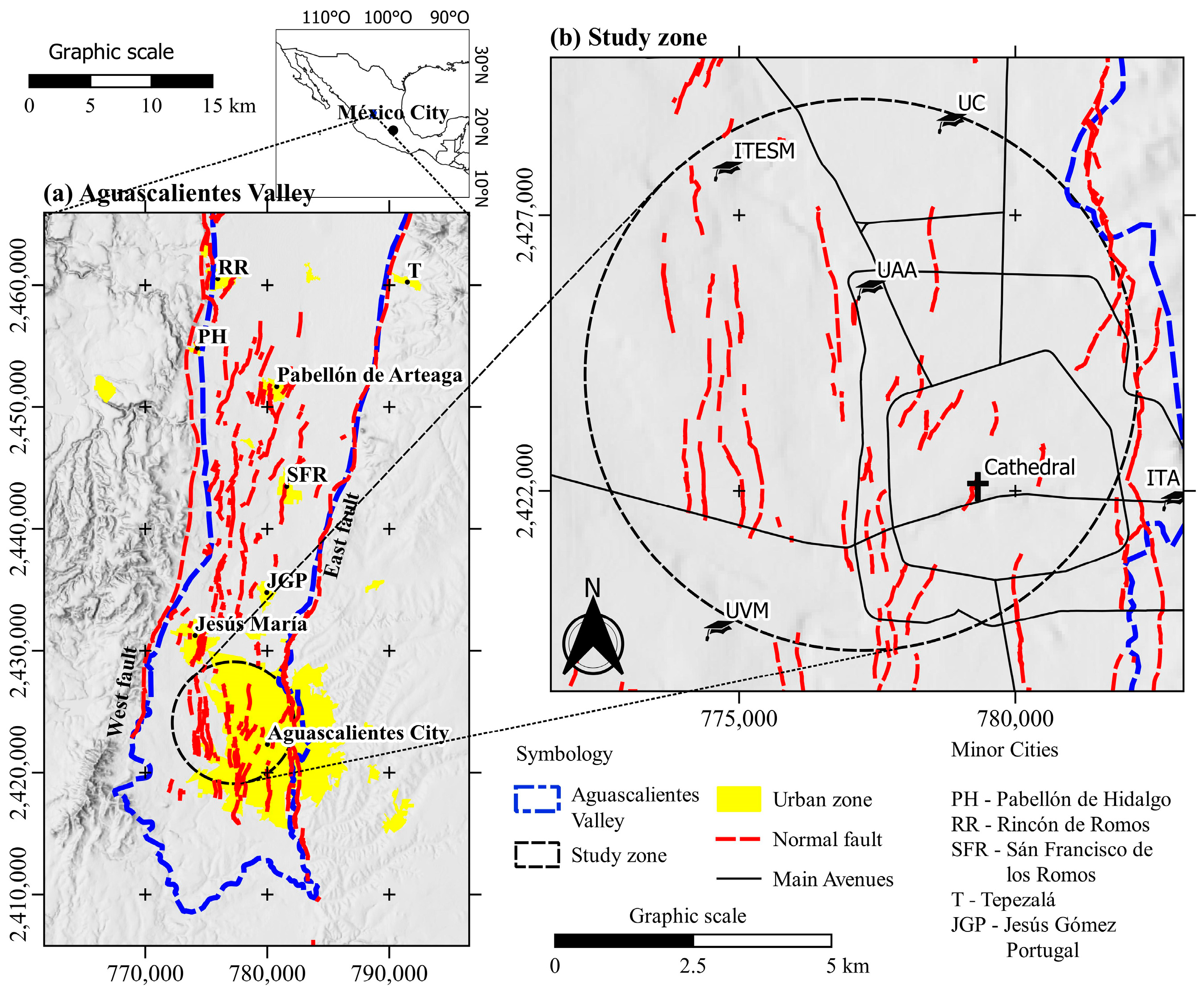
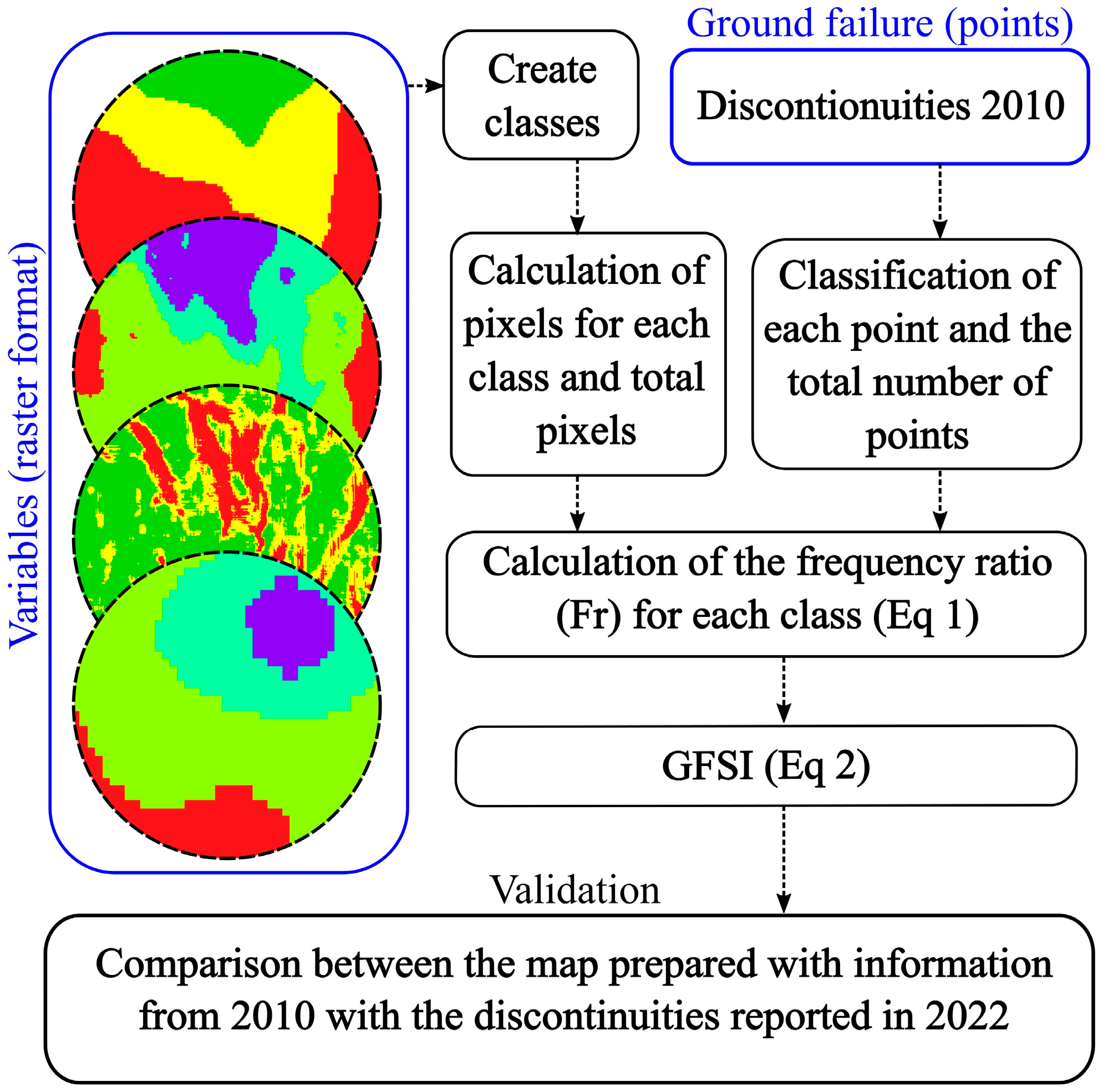
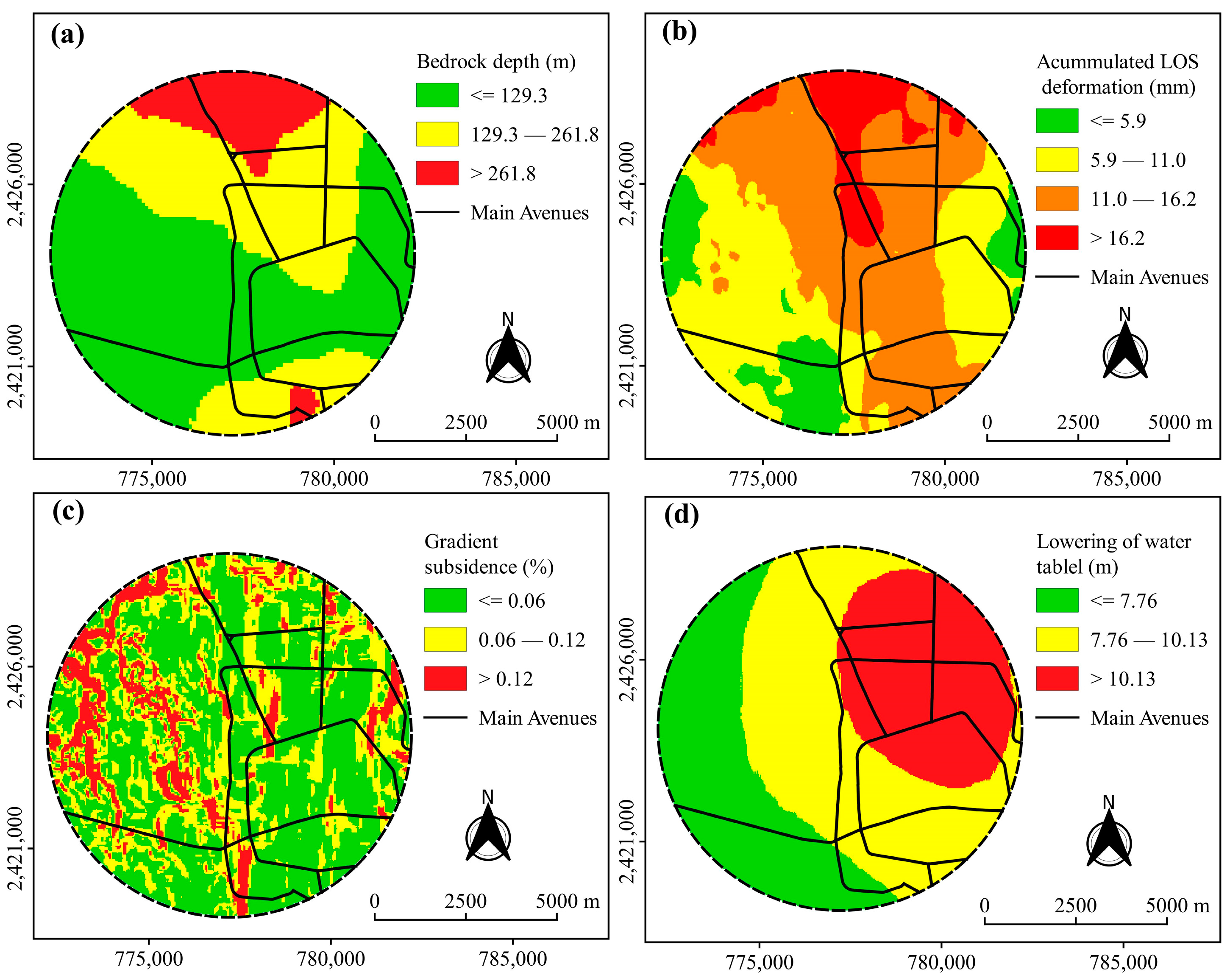
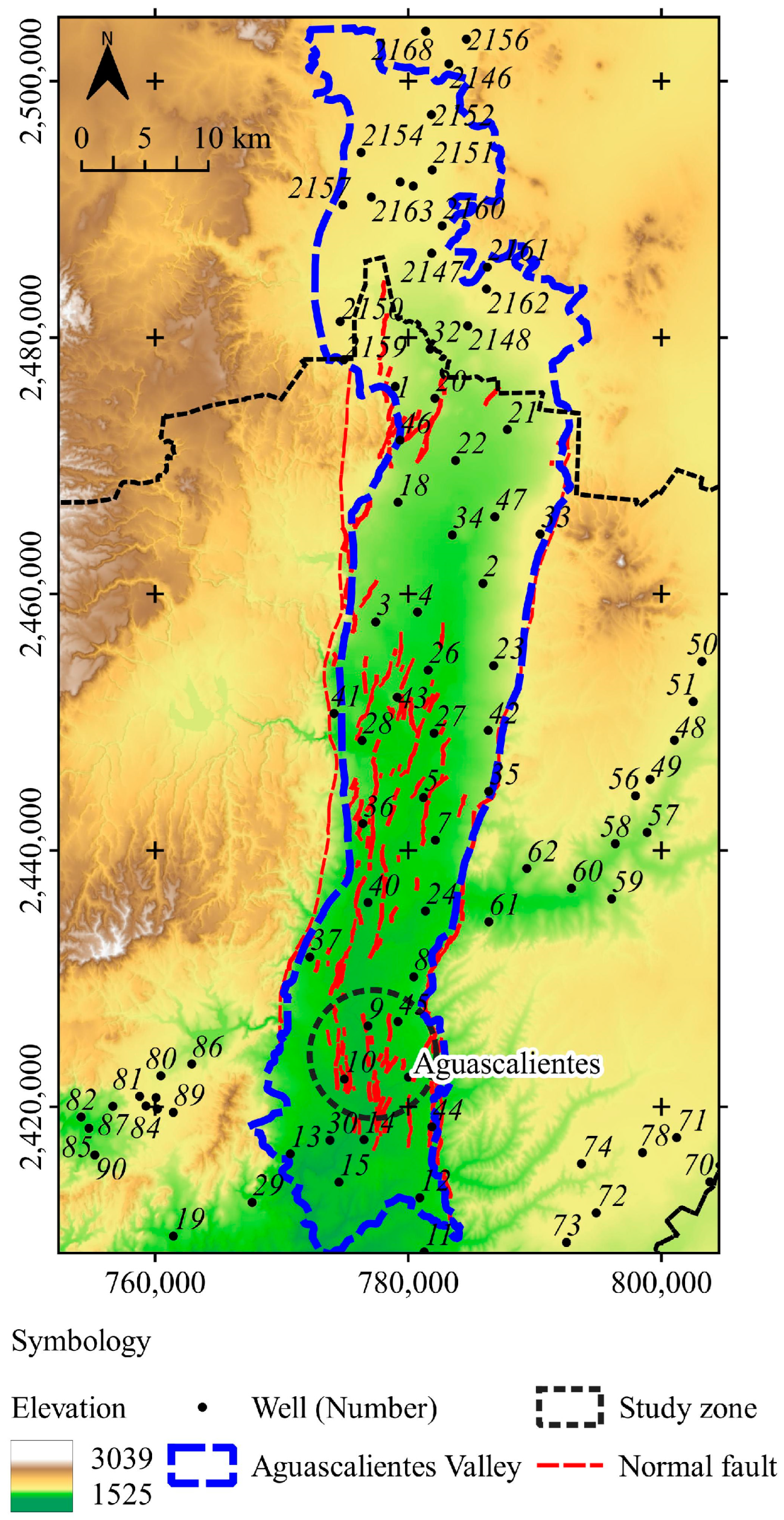
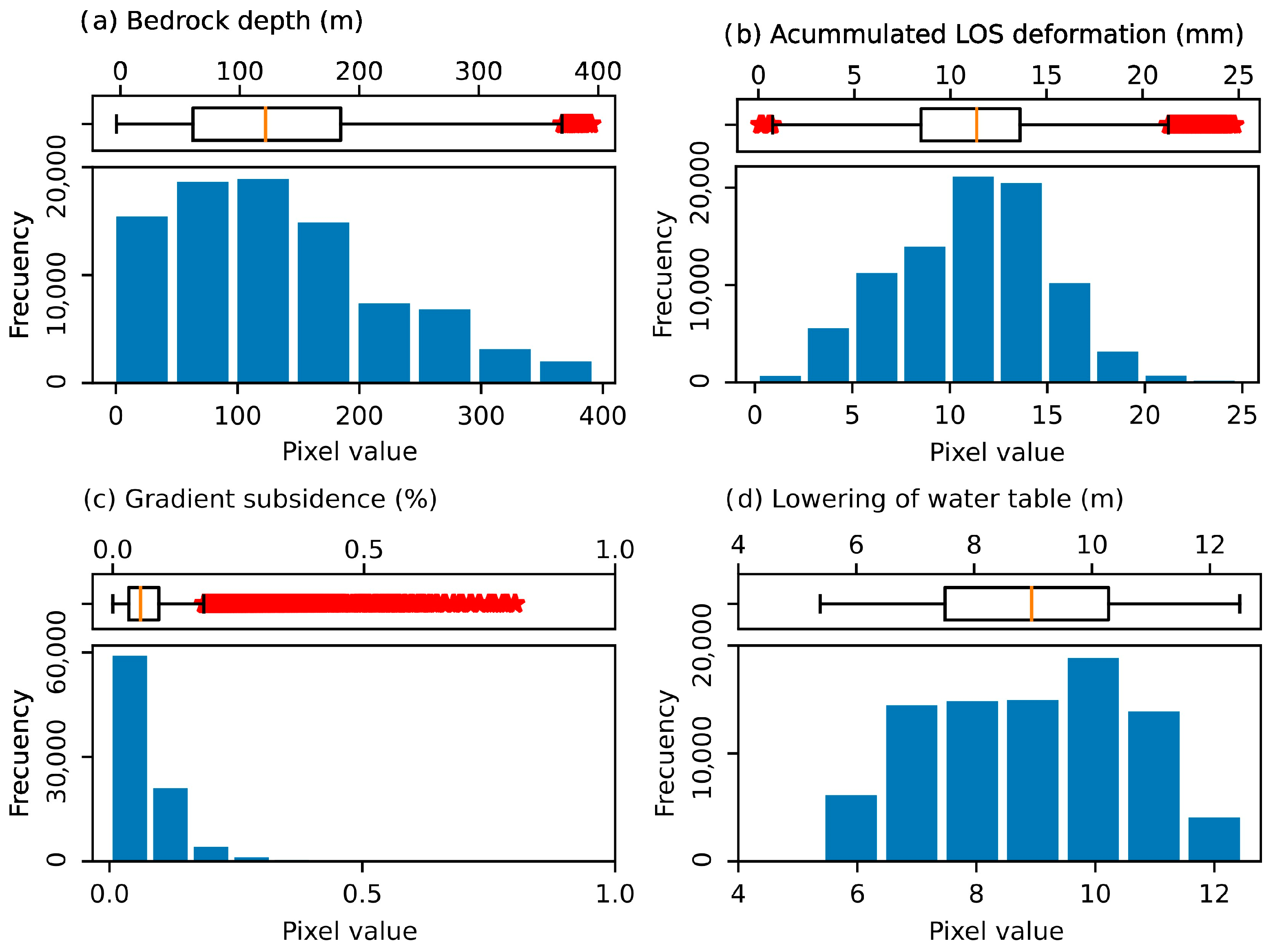
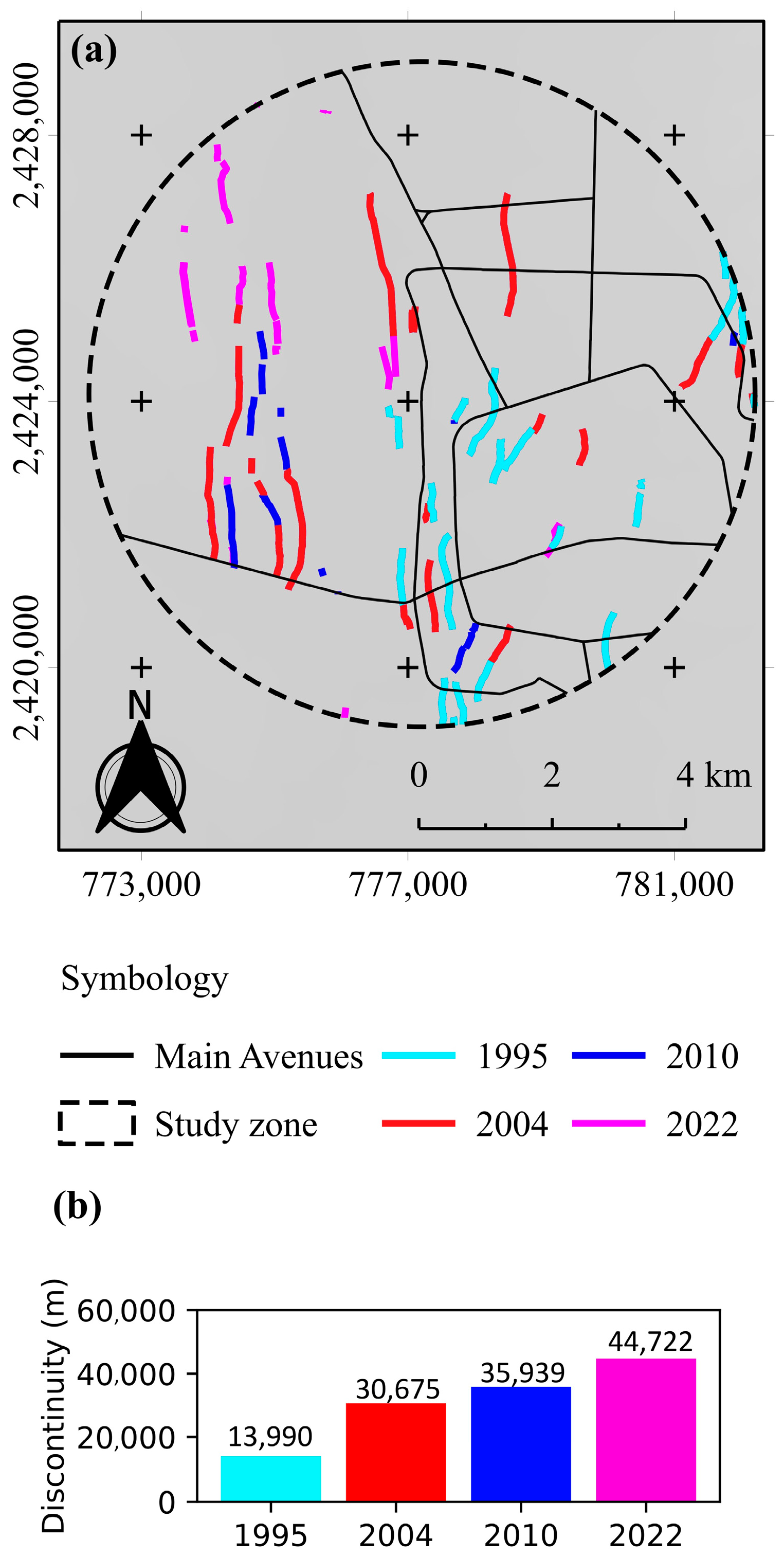
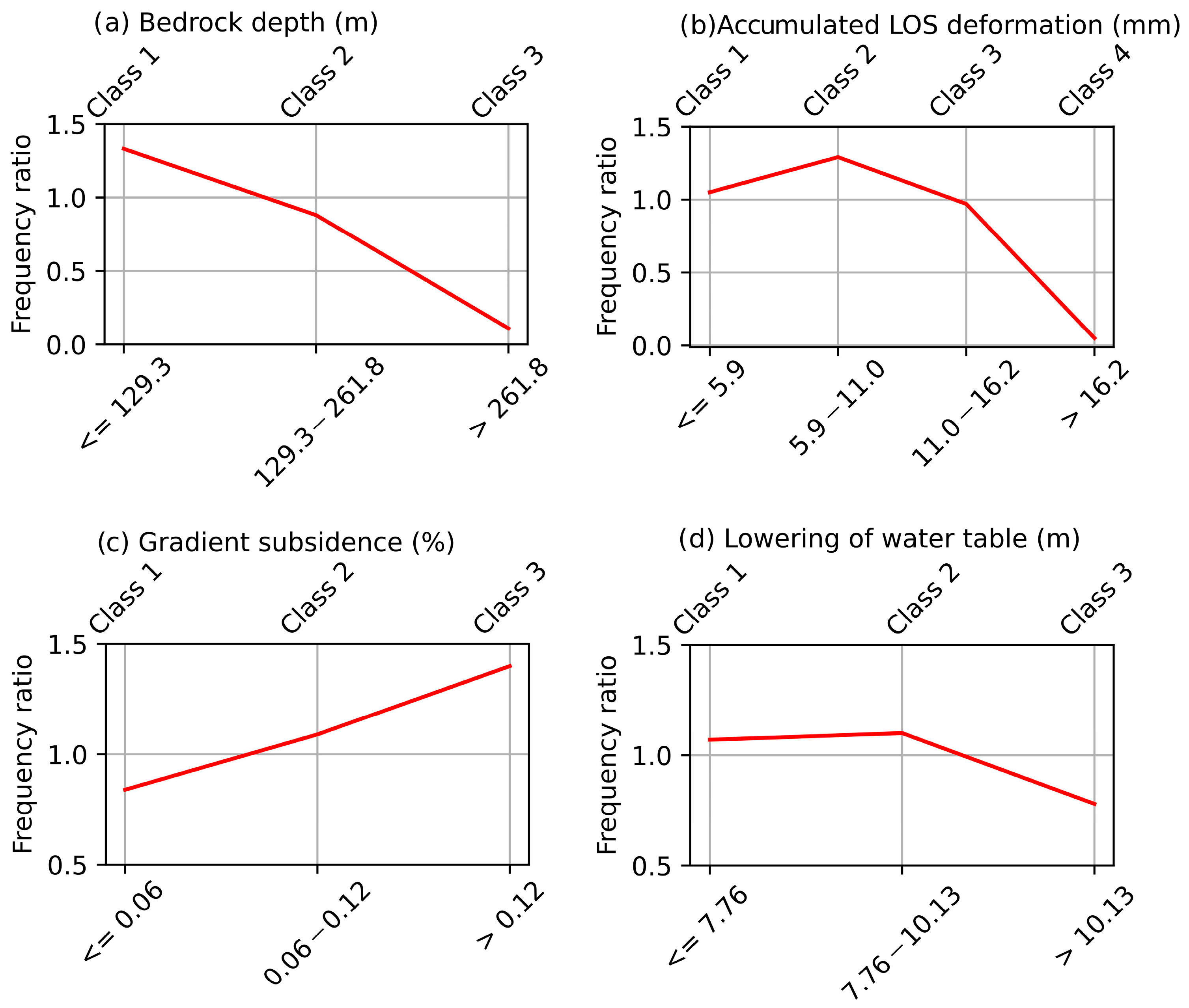
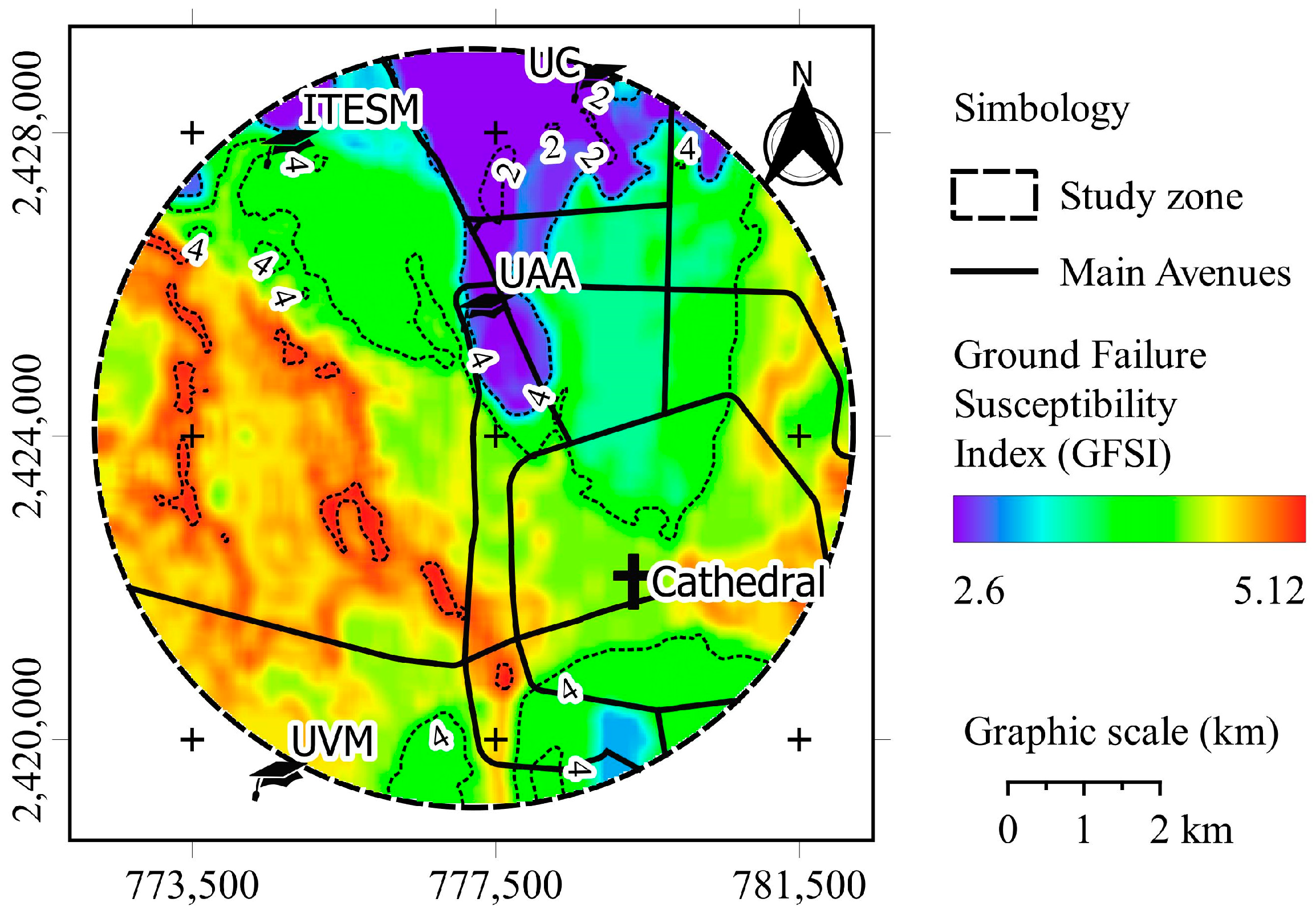
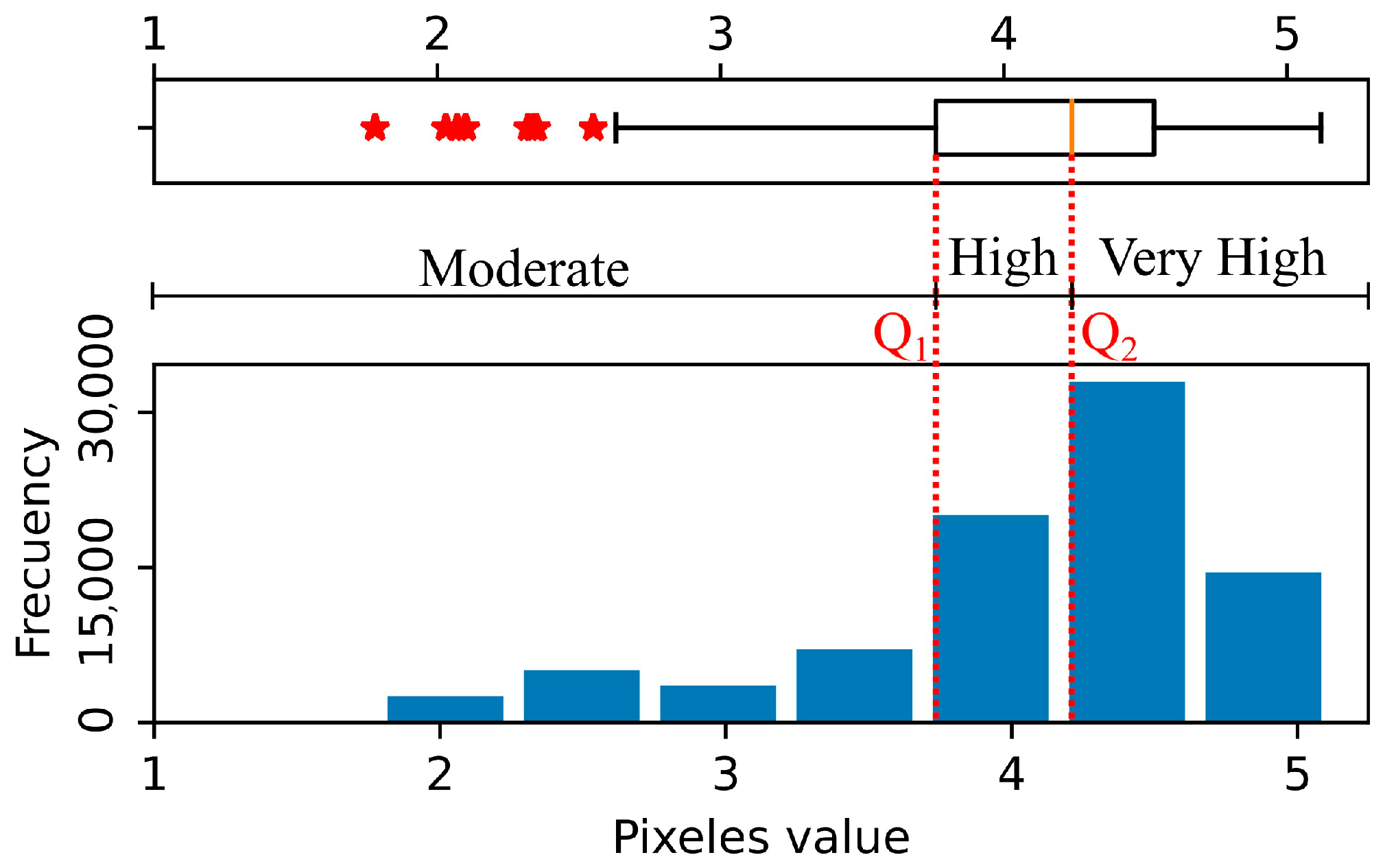
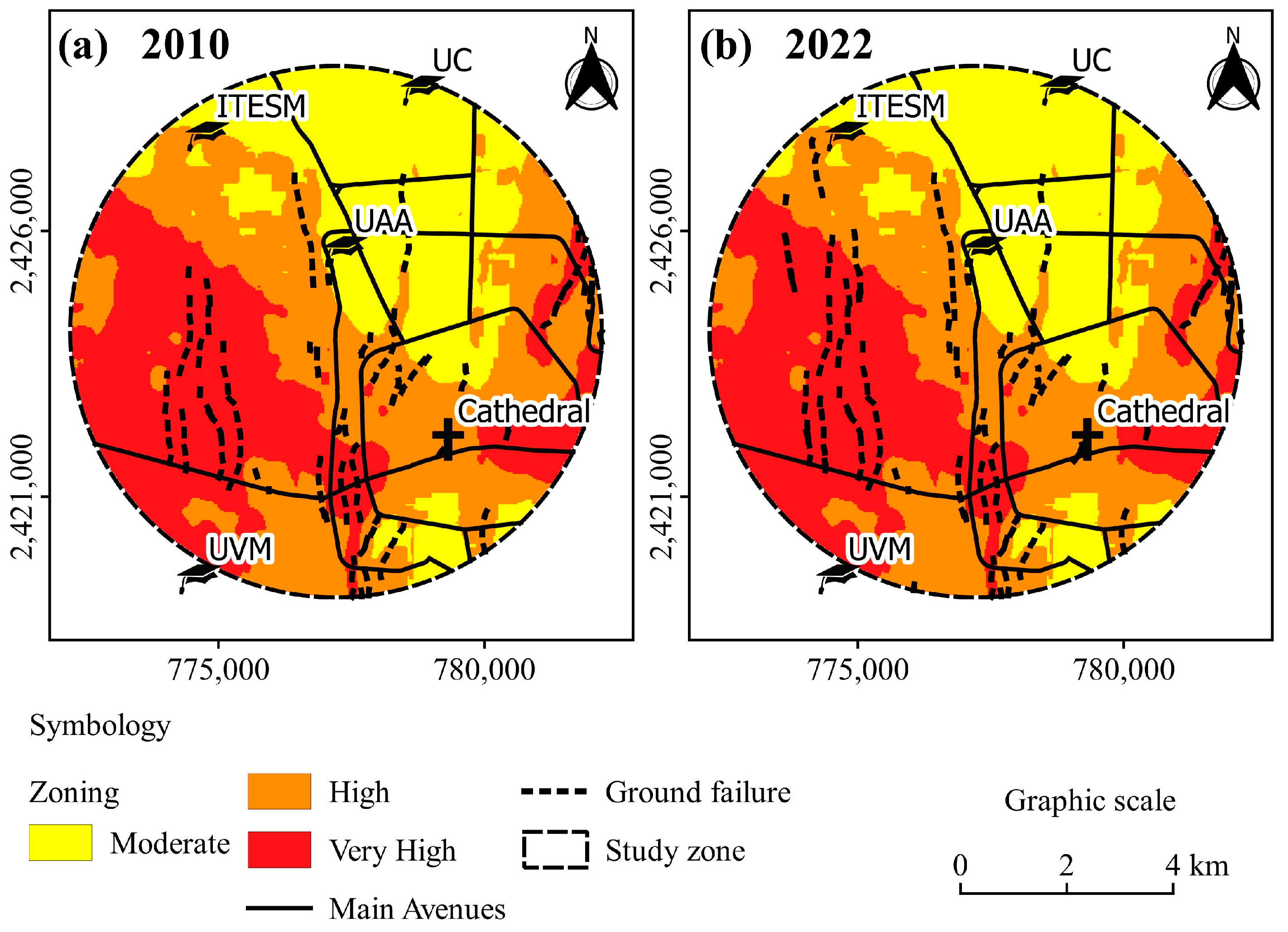
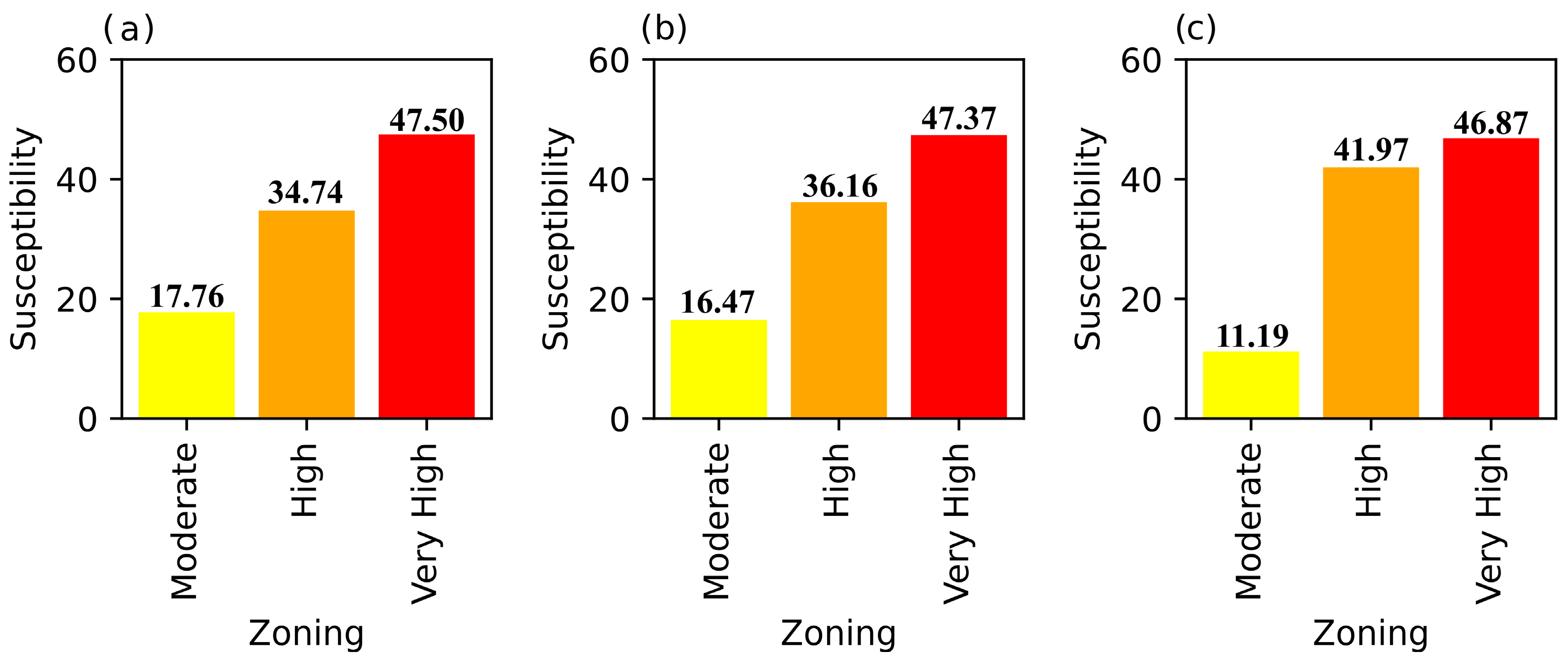
| Variable | Class | Class Interval | Number of Cells per Class | Percent | Number of Failure Points per Class | Percent | Frequency Ratio |
|---|---|---|---|---|---|---|---|
| Bedrock depth | 1 | ≤129.3 | 43,381 | 49.71% | 11,832 | 66.24% | 1.33 |
| 2 | 129.3–261.8 | 32,054 | 36.73% | 5766 | 32.28% | 0.88 | |
| 3 | ≥261.8 | 11,825 | 13.55% | 264 | 1.48% | 0.11 | |
| Accumulated LOS deformation or Subsidence | 1 | ≤−5.90 | 8729 | 10.00% | 84 | 0.47% | 1.05 |
| 2 | 5.90–11.0 | 38,029 | 43.58% | 7558 | 42.31% | 1.29 | |
| 3 | 11.0–16.2 | 30,292 | 34.71% | 8020 | 44.90% | 0.97 | |
| 4 | >16.2 | 10,210 | 11.70% | 2200 | 12.32% | 0.05 | |
| Gradient subsidence | 1 | ≤0.06 | 46,815 | 53.65% | 8084 | 45.26% | 0.84 |
| 2 | 0.06–0.12 | 27,851 | 31.92% | 6208 | 34.76% | 1.09 | |
| 3 | >0.12 | 12,594 | 14.43% | 3570 | 19.99% | 1.38 | |
| Lowering of water table | 1 | ≤7.76 | 25,305 | 29.00% | 5561 | 31.13% | 1.07 |
| 2 | 7.76–10.13 | 36,969 | 42.37% | 8319 | 46.57% | 1.10 | |
| 3 | >10.13 | 24,986 | 28.63% | 3982 | 22.29% | 0.78 |
Disclaimer/Publisher’s Note: The statements, opinions and data contained in all publications are solely those of the individual author(s) and contributor(s) and not of MDPI and/or the editor(s). MDPI and/or the editor(s) disclaim responsibility for any injury to people or property resulting from any ideas, methods, instructions or products referred to in the content. |
© 2023 by the authors. Licensee MDPI, Basel, Switzerland. This article is an open access article distributed under the terms and conditions of the Creative Commons Attribution (CC BY) license (https://creativecommons.org/licenses/by/4.0/).
Share and Cite
Luna-Villavicencio, H.; Pacheco-Martínez, J.; Ochoa-González, G.H.; Hernández-Marín, M.; Hernández-Madrigal, V.M.; López-Doncel, R.A.; Reyes-Cedeño, I.G. Determination of Susceptibility to the Generation of Discontinuities Related to Land Subsidence Using the Frequency Ratio Method in the City of Aguascalientes, Mexico. Remote Sens. 2023, 15, 2597. https://doi.org/10.3390/rs15102597
Luna-Villavicencio H, Pacheco-Martínez J, Ochoa-González GH, Hernández-Marín M, Hernández-Madrigal VM, López-Doncel RA, Reyes-Cedeño IG. Determination of Susceptibility to the Generation of Discontinuities Related to Land Subsidence Using the Frequency Ratio Method in the City of Aguascalientes, Mexico. Remote Sensing. 2023; 15(10):2597. https://doi.org/10.3390/rs15102597
Chicago/Turabian StyleLuna-Villavicencio, Hugo, Jesús Pacheco-Martínez, Gil H. Ochoa-González, Martín Hernández-Marín, Victor M. Hernández-Madrigal, Rubén A. López-Doncel, and Isaí G. Reyes-Cedeño. 2023. "Determination of Susceptibility to the Generation of Discontinuities Related to Land Subsidence Using the Frequency Ratio Method in the City of Aguascalientes, Mexico" Remote Sensing 15, no. 10: 2597. https://doi.org/10.3390/rs15102597
APA StyleLuna-Villavicencio, H., Pacheco-Martínez, J., Ochoa-González, G. H., Hernández-Marín, M., Hernández-Madrigal, V. M., López-Doncel, R. A., & Reyes-Cedeño, I. G. (2023). Determination of Susceptibility to the Generation of Discontinuities Related to Land Subsidence Using the Frequency Ratio Method in the City of Aguascalientes, Mexico. Remote Sensing, 15(10), 2597. https://doi.org/10.3390/rs15102597










